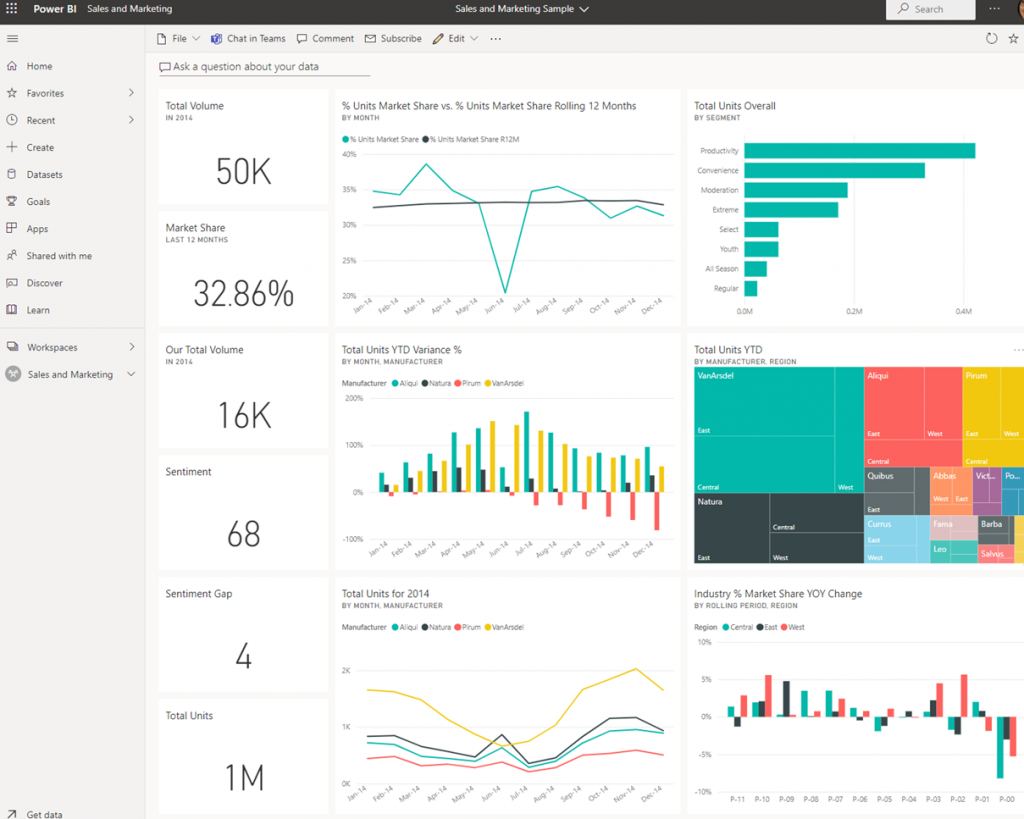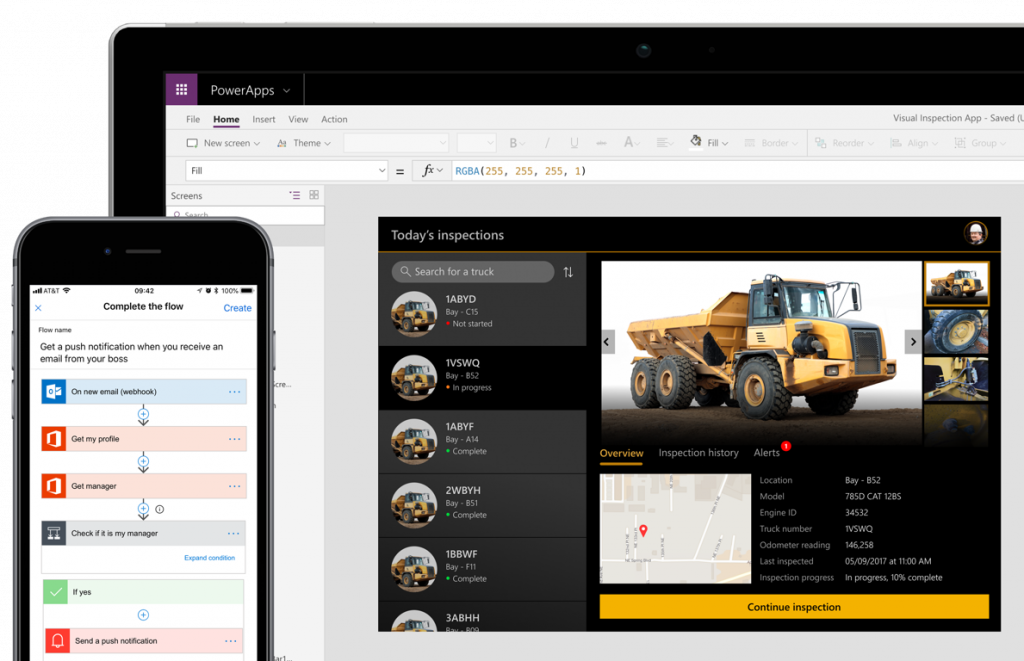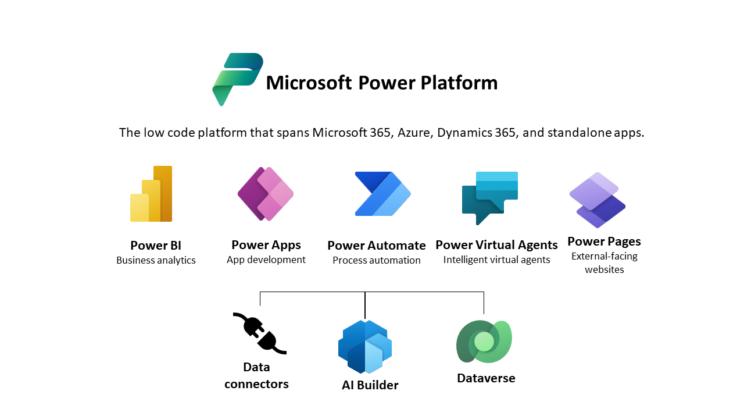
Microsoft has always been both technically intricate, granular, and powerful in the eyes of hard-core software developers as well as user-friendly and intuitive in the eyes of the “vanilla” users so that anyone can use the out-of-the-box solutions. Lately, there’s been a lot of talk around the new Microsoft’s Power Platform, which incorporates both approaches into one product. The tech giant says the platform is aimed at empowering people to achieve more; Forbes says it is here to “make other people cool.” What’s the real purpose and the big idea behind this new toolkit?
Microsoft CEO Satya Nadella said, “You join here, not to be cool, but to make others cool.” This means it’s not always about being the most amazing software engineer that creates the next big thing. Instead, it’s about creating amazing software power and putting that power in the hands of people who need it.
What is the Microsoft Power Platform? Power Platform isn’t a product on its own; rather, it’s a range of integrated tools that are designed to unlock the potential of your other Microsoft applications. It’s built around three primary solutions:
- Power Apps for building custom applications
- Power BI for analytics and reporting
- Microsoft Power Automate for business processes and workflow
Power Platform is a suite of “no code needed” solutions. The real draw is that it can integrate with hundreds of data sources through various connectors to maximize the usefulness of your data.
The Vision for Power Platform
Now leveraging data is not a “know-how” or a novice approach for organizations worldwide. The value of using the cloud storage, gathering data from a multitude of sources (web traffic, social media, and CRM/ ERP apps) to drive business outcomes is obvious. So, imagine you’ve got all your ducks in a row, you’ve set up the infrastructure for collecting data, now what? How would you make the data “work for you”? You’ll need a straightforward way for all your teammates, regardless of technical inclinations, to use it to drive business impact. That’s exactly what the Power Platform is designed to do. The Power Platform is a combination of Power BI, Power Apps, and former Flow (now Power Automate.) It is a system that enables users to be able to take three key steps to “make” raw data to help them drive business results.

Power BI is Here to Help Analyze Data You’ve Collected
Power BI is a business intelligence tool that allows you to visualize data and share useful information with colleagues or embed data in an application or website. Connect to hundreds of data sources and breathe life into your data with dynamic dashboards and reports. View your data in new ways. Make informed decisions quickly. Upload, model, and explore your data with visual reports and then publish it, share it with other users, and use it when working together. Power BI integrates with other tools, including Microsoft Excel, so that you can get started quickly and seamlessly use this service with existing solutions. Connect to your data wherever it is. Then explore your data using amazing interactive visualizations.
Power BI is a business intelligence solution designed to give visual representations of your data for insights into your organization’s performance. You may already be familiar with the concept of dashboards and KPIs; Power BI is Microsoft’s take on this. The most obvious purpose of Power BI is to use it to create dashboards to represent your organization’s performance. However, there are lots of methods available for depicting your data:
- You could have a screen within your offices demonstrating the performance of each team against their monthly targets.
- Departmental managers could access dashboards demonstrating their team’s performances rather than manually compiling metrics.
- Directors can have a dashboard to review during the month and another to show at board meetings.
However, we mustn’t consider Power BI to be static representation of data. They’re a dynamic solution that allows you to explore the data further and to investigate anomalies by drilling down into the data, without having to switch between your various business applications to do so. Further to this, you can embed various other assets into Power BI. For example, it’s easy if you want to embed a PowerPoint slideshow to include additional information when presenting to the board. You can also extract data out of Power BI into an Excel spreadsheet and then pivot or manipulate the data as needed.
We also can’t miss out on the collaborative nature of Power BI. If you’re reviewing a dashboard and notice an anomaly, you can ask questions of your colleagues through the Power BI application itself (e.g. “@Paul, please investigate low sales in March” would lead to Paul getting a notification linked directly to the corresponding chart). If your organization uses Microsoft Teams, you can even embed Power BI charts into your chats or teams.
Power Apps Allows Taking Actions with the Data as well as the Results of Your Analysis
Power Apps is a suite of applications, services, connectors, and data platforms that provides a fast application development environment for building custom applications to meet your business needs. Using Power Apps, you can quickly create custom business applications that connect to business data stored in either the Common Data Service platform or various network and local data sources (SharePoint, Excel, Office 365, Dynamics 365, SQL Server, etc.).
Applications created using Power Apps provide rich business logic and workflow capabilities that enable you to transform business processes into automated digital processes manually. Besides, applications created using Power Apps are responsive to development and can easily work in a browser or on mobile devices (phone or tablet). Power Apps “More Democratic” is a user-driven business application creation process that allows users to create fully functional, custom business applications without writing code.

A Power App can be a mobile phone or tablet application (published on iOS, Android, and Windows application stores) or a browser-based application (published as a website). Microsoft categorizes Power Apps into three different types when building them:
- Model-driven Apps – start with the data source(s), and bring in the design afterward (most useful for Dynamics 365 data sources)
- Canvas Apps – start by designing the look and feel of the app, and connect to the data source(s) as you go (most useful for other data sources)
- Portals – for creating web portals, allowing customers, employees, partners, or wider communities to interact with you via a dedicated application
The capability of Power Apps shouldn’t be underestimated, and the use cases are endless. Here are a few ideas for apps that you could create:
- A customer portal, linked to Dynamics 365, that allows customers to view knowledge articles, and submit and track support cases.
- An employee expenses app, allowing your employees to enter details of any expenses they’ve incurred, and attach photographs of receipts or invoices.
- A one-off events competition entry app, allowing attendees to enter competitions at your exhibition stand, with an opt-in form for your marketing list.
- A product showcase allows customers who visit your premises to browse the products you offer.
These are just a few simple examples, but more complex solutions are possible. For example, Autoglass use Power Apps for various purposes, the most noteworthy being that their mobile technicians can now view and complete the jobs to which they’re assigned, and the back-office system is automatically updated with their progress. Their app even has an augmented reality interface allowing the correct windscreen to be selected by overlaying on top of a live image of the vehicle, in the case of needing a replacement.
Power Automate is Here to Automate (Obvious from the Name) the Data Flow
Microsoft Power Automate is a task automation and application integration service. Power Automate is a cloud service. This service allows you to create automated workflows between applications and services. With Power Automate, you can receive notifications, synchronize files, collect data, and automate many routine operations. As a result – to make life easier and more comfortable. Power Automates’ motto is “Work less, do more.” Microsoft Power Automate supports not only Microsoft services and applications but also many other popular services. For example, Dropbox, Google Tasks, Slack, Trello, and many others. Of course, the developers focused on integration with Office 365 services. It is very good that Project Online is also supported. Power Automate must allow developers to expand the capabilities of the service. The following is a list of currently supported applications and cloud services.
The combination of these tools allows any employee, from the CEO to the front-line workers, to drive the business using data. Power Platform, by combining these tools and getting them to working together atop your data, makes your raw data into solid gold without any spinning wheel. A Power Automate is a series of steps that automate a function or task that the user performs.
- Automated Tasks
- Scheduled Tasks
- A triggered action such as a button click
- Business processes
Each of these utilizes the Common Data Service, but a host of third-party connectors allow users to connect to applications outside of this. If there is no existing endpoint connector for your desired application, a custom one can be created with the correct knowledge. Power Automate uses the if-then this argument whereby the trigger action causes the ‘if’ statement to be questioned. If that statement returns true, the next step in the branch of the Power Automate is processed, triggering the ‘this’ part of the argument.
Power Automates is a starting point that utilizes drag-and-drop functionality for its connectors and includes an intelligent business sense that narrows down connector options based on the selected arguments. This can be overruled by the creator enabling Power Automates to be many and varied in their application and use. For example:
- Whenever an email containing an attachment is sent to a user, automatically organize the document into a SharePoint folder structure.
- Introduce an approval procedure to an employee expenses Power Apps.
- Post new Outlook tasks to a Trello board.
- Saving tweets with specific hashtags to a SharePoint document for targeted marketing purposes.
Multi-million Community
The combination of Power BI, Power Apps, and Power Automate is a pack of technologies wrapped up under the Microsoft Power Platform brand. Each of these services individually is already the top of the market solution. So, the combination of them has no equals in today’s market. This accomplishes certain consistency in combining a selection of heavyweight back-end technologies to hard-core developers and shows a way to get applications and data to work the way they want to so-called “citizen developers,” who are basically business people.
While it is obvious how to make a positive business impact with Power Platform, it also allows to fruitfully impact the customers – starting with the term “citizen developer” created for the “user” who strives for more excellent knowledge in programming and software development. Power Platform’s power is in making “the secret art” of creating software much more interactive and curious for the user. More so, when technology is made approachable, the community around the technology grows. And we all know that magical things are possible when technology is accessible to those in the best position to identify transformation and guide businesses into these transformations. The community of those who’ve discovered the Power Platform learned all the nukes and crannies, harvested all the perks, and encouraged the change for their organizations in the process is growing.

The immediate future of the Power Platform is bright. Microsoft is concentrating its efforts on refining the Power Platform experience, making Power Apps easier to deliver, and creating a unified Admin Centre for ease of administration. In the mid-to-long term, Microsoft has yet to announce its plans for the Power Platform. In our opinion, Microsoft’s emphasis on citizen development needs to focus on making Power Platform more accessible for those wanting to have a go.
It’s all well and good saying that Microsoft has done a great job of making Power Platform intuitive and continues to do so with constant updates.
For more info on Microsoft 365 visit – Seven IT Pro – Power Platform Experts
To book a free consultation for Microsoft power platforms related queries -Book a free consultation Meetings (office365.com)
Leave a Reply